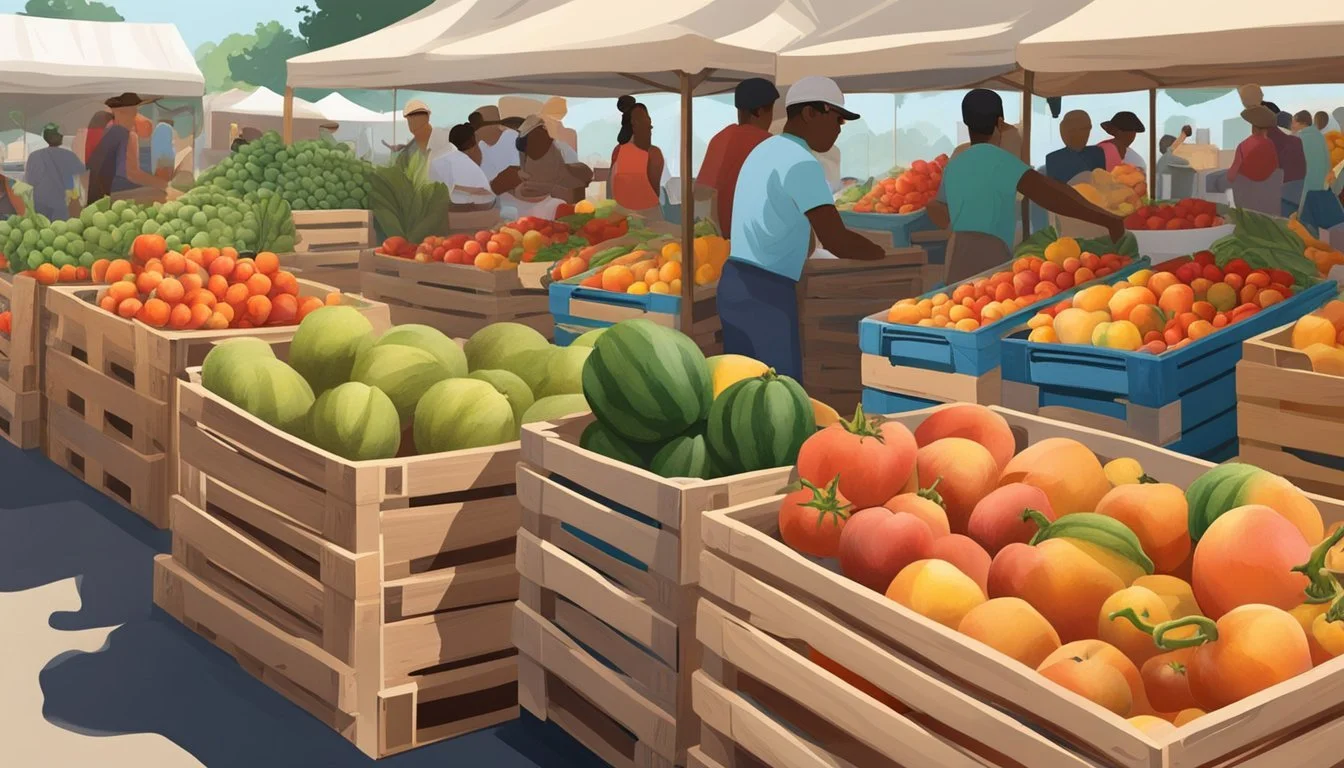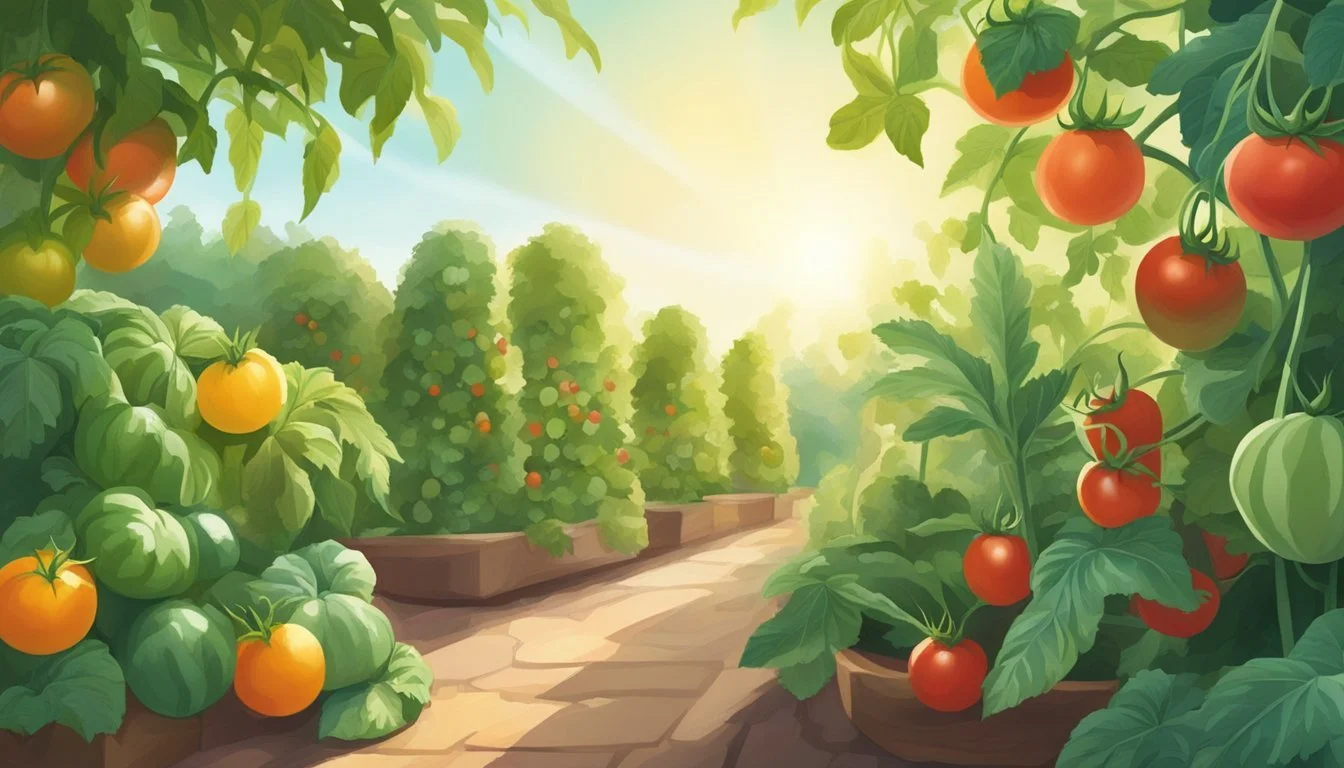Louisiana Seasonal Fruit & Vegetables in August
A Guide to Fresh Produce
This Article is Part of our Louisiana Seasonal Fruit & Veg Calendar
In Louisiana, the month of August is a bountiful period for harvest, marking the height of summer with an array of fresh produce reaching its peak ripeness. The warm Southern climate and rich delta soil provide an ideal environment for an assortment of fruits and vegetables to flourish. From the tangy sweetness of blueberries to the refreshing crunch of watermelon, local farmers' markets become a showcase of vibrant colors and fresh flavors.
Among the mainstays of August produce in Louisiana are sweet and juicy fruits like peaches and blueberries, which have enjoyed the sun's nurturing rays throughout the summer. Vegetables such as okra, which thrives in the heat, and bell peppers (What wine goes well with bell peppers?), a staple in the regional cuisine, are also readily available. The selection of fresh produce in season not only promises high quality but also supports local agriculture and sustains the state's rich culinary traditions.
Consumers looking to incorporate fresh, local ingredients into their meals will find that August's offerings provide a taste of Louisiana's agricultural bounty. These summer harvests allow for a myriad of dishes that are both nutritious and flavorful, celebrating the state's gastronomic heritage. Whether used in traditional recipes or innovative culinary creations, the fruits and vegetables of Louisiana in August are a testimony to the state's fertile grounds and agricultural expertise.
Overview of Louisiana's Seasonal Crops
In August, Louisiana's gardens thrive, offering a generous yield of both fruits and vegetables. The state's climate, falling within zones 8 and 9, supports a diverse range of produce. During this month, the heat is conducive to the growth of many warm-season crops.
Fruits:
Peaches: Reaching the tail-end of their season.
Figs: In full harvest, providing sweet and succulent fruit.
Muskmelons: Such as cantaloupe (how long does cantaloupe last?), refreshing and abundant.
Vegetables:
Okra: An essential Southern crop, grows exceedingly well in the heat.
Eggplant (What wine goes well with eggplant?): Purple and glossy, commonly found in local gardens.
Peppers: From sweet to spicy, a multiplicity of varieties flourish.
Southern peas: Such as black-eyed peas (how long do black-eyed peas last?), crowding the vegetable patches.
Sweet potatoes: Beginning their main harvest towards the end of the month.
The gardening community in both South Louisiana and throughout the city landscapes takes pride in the seasonal bounty. While local farmers' markets showcase the vibrant produce, gardeners often share their surplus with neighbors, strengthening community ties.
Air humidity plays a significant role in what can be grown; tender greens are generally less successful in the August heat. However, many gardeners prepare their soil for the fall crops, anticipating the next cycle of planting. Louisiana's culinary culture treasures August's produce, incorporating fresh, locally grown vegetables and fruits into traditional and contemporary dishes alike.
August Fruit Harvest in Louisiana
August in Louisiana marks a period brimming with ripe, juicy fruits ready for harvest. This is an ideal time for fruit enthusiasts and home canners to take advantage of the state's bountiful produce.
Stone Fruits and Berries
Peaches: They are the stars of the stone fruit family in August with several varieties reaching peak ripeness. This is certainly the time to savor the sweet and juicy peaches of Louisiana.
Figs: These soft, sweet fruits are also readily available. One can find both fresh figs and processed fig products like jams and preserves during this time.
Melon Varieties
Cantaloupes: August is the perfect month for the harvest of cantaloupes in Louisiana. Their rich, sweet flavor, and fragrant aroma mark them as a seasonal treat.
Watermelon: Synonymous with summer, this quintessential melon is in abundance. Full of hydration and sweet flavor, watermelons are perfect for hot August days.
Honeydew: Another melon to look out for is the honeydew, known for its smooth, pale green flesh and subtly sweet taste. Honeydew melons are typically harvested when they reach a mild, creamy ripe state.
Fruit markets and farm stands across Louisiana showcase these seasonal delights, offering a taste of the freshest fruits straight from the local orchards and farms. Whether incorporated into dishes or enjoyed on their own, each fruit provides a unique flavor profile characteristic of the vibrant agricultural tapestry of the state.
August Vegetable Picks
In August, Louisiana gardens offer an abundance of vegetables that are at their peak in flavor and nutritional value. The following subsections detail the variety of vegetables that thrive during this month.
Leafy Greens and Herbs
Louisiana's warm climate in August is ideal for growing a range of leafy greens and herbs. Gardeners can enjoy a bountiful harvest of greens including:
Kale: This nutrient-rich leafy green thrives despite the heat.
Spinach: Tender and full of vitamins, spinach can be harvested in early August before the summer heat intensifies.
Arugula: (how long does arugula last?)With its peppery flavor, arugula adds a kick to any salad.
Swiss Chard: This colorful green brings both beauty and a slightly sweet taste to the garden.
Collard Greens: A Southern staple, collard greens are versatile and full of essential nutrients.
Herbs such as rosemary, sage, parsley, and basil are also in abundance, providing fresh flavors for any dish.
Root Vegetables and Gourds
Root vegetables and gourds also do well in August's warm soil. Gardeners can find:
Carrots: Crunchy and sweet, perfect for both raw and cooked dishes.
Sweet Potatoes: A nutritious and filling option that starts its prime season.
Squash: Includes varieties like summer squash, which are perfect for grilling.
Zucchini: These vegetables are fast growers and extremely versatile in the kitchen.
Pumpkins: Beginning to appear in the garden, they hint at the upcoming fall season.
Nightshade and Cucurbit Vegetables
The nightshade and cucurbit families are well-represented in August:
Eggplant (What wine goes well with eggplant?): Glossy and ripe, these are ready for a range of culinary uses.
Tomatoes: They are at their juiciest and can be found from cherry to beefsteak varieties.
Cucumbers: (how long do cucumbers last?) Crisp and perfect for refreshing salads.
Peppers: From sweet bell peppers to hot varieties, they add flavor and color to any meal.
Podded Vegetables and Others
Finally, we see a variety of podded vegetables and other hearty produce:
Okra: This heat-loving crop is ideal for gumbos and stews.
Beans: Fresh green beans and bush beans are tender and full of fiber.
Peas: Though less common in the heat, some resilient varieties might still be harvested.
Corn: Sweet corn is in its prime, ready for boiling, grilling, or creaming.
As Louisiana's August sun encourages growth, these vegetables contribute to a sustainable and nutritious harvest season.
Nutritional Benefits of Seasonal Produce
Consuming seasonal produce harvested in August in Louisiana offers an array of nutritional advantages. These fruits and vegetables are not only fresher but also tend to be higher in vitamins and minerals, as they are picked at their peak ripeness. Here are some notable benefits:
Vitamins & Minerals: Seasonal fruits and vegetables are typically rich in a variety of essential nutrients. They may provide a higher content of vitamins such as Vitamin C and Vitamin A—important for immune function and vision, respectively.
Dietary Fiber: Locally grown produce like tomatoes and sweet potatoes are sources of dietary fiber, which promotes digestive health.
Antioxidants: The dark green and red/orange subgroups of vegetables harvested during this time, such as bell peppers and leafy greens, contain antioxidants. These compounds help protect the body against oxidative stress.
Table: Nutritional Highlights of Louisiana's Seasonal Produce in August
Produce Type Key Nutrients Health Benefits Dark Green Vegetables Vitamins A, C, K, Iron, Calcium Supports eye health, blood health, and bone strength Red/Orange Vegetables Beta-carotene, Vitamins A and C Aids in maintaining healthy mucous membranes and vision Starchy Vegetables Complex Carbs, Fiber, B-vitamins Provides energy, supports metabolism
In addition to these nutrients, seasonal produce can contribute significantly to a balanced diet. It often contains fewer pesticides and may have a smaller environmental footprint due to reduced transportation and storage times. By incorporating seasonal fruits and vegetables into their diets, individuals can enjoy flavors at their peak while nurturing their health.
Preparing Louisiana's Seasonal Produce
In August, Louisiana gardens deliver a bounty of fresh produce. A focus on proper preparation techniques can enhance the flavor and longevity of these seasonal fruits and vegetables. This section offers insights into cooking and preserving the best of Louisiana's harvest.
Recipes and Cooking Tips
Cucumbers:
Salads: Use thinly sliced cucumbers for a refreshing summer salad. Dress with vinaigrette for a tangy twist.
Pickling: Fresh cucumbers can be pickled using vinegar, dill (how long does dill last?), and garlic for a crunchy side or snack.
Eggplant:
Grilling: Sliced eggplant brushed with olive oil and herbs can be grilled until tender.
Casseroles: Incorporate cubed eggplant into ratatouille (What wine goes well with ratatouille?), showcasing the flavors of local cuisine.
Corn:
Boiling: Boil husked ears for 3–5 minutes for a simple yet delicious side.
Grilling: Grill corn with the husks on for a smoky flavor.
Figs:
Jams: Cook down figs with sugar to create a rich, spreadable jam.
Desserts: Fresh figs add natural sweetness to pastries and desserts.
Preservation and Storage Methods
Freezing:
Corn: Shuck, blanch for 2 minutes, cool, then freeze to preserve freshness.
Figs: Wash, dry, and freeze whole on a baking sheet before transferring to airtight containers.
Canning:
Pickles: Cucumber pickles can be canned in a vinegar brine using a water bath method.
Jams: Fig jam (how long does fig jam last?) can be canned and sealed for long-term storage.
Drying:
Herbs: Tie fresh herbs in bunches and hang to dry in a cool, airy space.
Peppers: Slice peppers and lay flat on a screen to air dry; store in airtight containers.
Storage Tips:
Eggplant: Store in a cool place, away from direct sunlight, and use within a few days to maintain freshness.
Cucumbers: Keep cucumbers in the fridge to preserve their crispness for up to one week.
Growing Your Own Seasonal Produce
Louisiana's climate in August is conducive for growing a variety of fruits and vegetables. Home gardeners can take advantage of this period to cultivate produce that thrives in warm conditions.
Planting Calendar and Guidelines
The typical Louisiana planting calendar underscores August as a transitional period. Gardeners should consider sowing seeds that fare well in both the tail end of summer and the onset of fall. Below is a table showing suitable home gardening crops for August planting:
Vegetables to Plant Fruits to Plant Okra Figs Southern peas Muscadines Squash Persimmons Pumpkins Pomegranates Sweet Potatoes
Seasonal gardening in Louisiana involves understanding the local climate and soil conditions. During this month, gardeners should prioritize crops that can withstand the heat and still reach maturity before the cooler autumn temperatures set in.
Care and Harvesting Tips
Gardens require regular maintenance such as watering, pruning, and pest control to ensure robust yield. Here are a few tips for gardening in August:
Watering: Consistent and deep watering is critical due to the August heat, particularly for young plants that are establishing roots.
Pruning: Remove dead or yellowing leaves to allow plants to focus energy on growth and fruit production.
Harvesting: Regular harvesting encourages more production. Vegetables like okra and Southern peas should be picked frequently.
When it comes to garden maintenance, the gardener must be vigilant in their routine. This involves checking for signs of pests and diseases and taking immediate action to mitigate any issues. Moreover, adding a layer of mulch can help retain soil moisture and keep roots cool.
By adhering to these guidelines, home gardeners can make the most of their efforts in seasonal gardening and enjoy a bountiful harvest.





